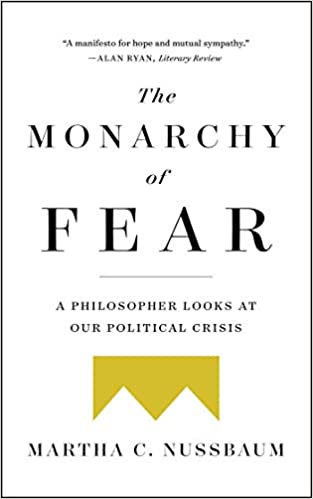When I wrote this poem last fall, using the 5-7-5 syllable haiku formula, I really didn’t have an answer to the question it poses.

But it’s nagged at me. I have a t-shirt worn to demonstrations that reads LOVE/fear (love over fear). But the t-shirt doesn’t fully answer the question either. Then I ran across a book by the popular philosopher Martha C. Nussbaum that goes directly to the point. Here’s the cover:

Nussbaum writes:
“We’ve said from the outset that hope is the opposite or flip side of fear. Both react to uncertainty, but in opposing ways. Hope expands and surges forward, fear shrinks back. Hope is vulnerable, fear self-protective.”
So by Nussbaum’s reckoning, fed by her deep reading in the classic philosophers and astute observations about popular fare like Lin Manuel Miranda’s Hamilton, the answer to my high coo’ed question might be:
If hate is just fear
spewed onto others then love
is hope in action.
I’m not entirely satisfied with this equation (or the way the new poem parses) either. After all, doesn’t love often express itself best in situations where there is no hope, for instance in holding the hand of a dying friend (or in today’s climate, placing a hand up to theirs on a window pane)? But I like the way Nussbaum’s definitions allow friction to operate on these heavily loaded four-letter words. She describes how fear and hate, like sticks rubbed together, feed each other’s fire. Hope and love, like palms rubbed together, warm the hands that reach out to touch.
So I’m thinking that hope and love, framed in this way, can be practiced as solutions to fear and hate. When fear emerges, because of pain or misunderstanding or perceived danger, then hope can arise, too, perhaps aided by the behavioralists’ A-B-C (accept-believe-challenge) ritual, so that love can blossom where hate might have seeded instead. For example, the coronavirus is deadly, terrifying and unpredictable. But because it’s hard to hate a microbe, fear instead feeds on various strategies for hiding one’s head in the sand: distrusting science, disbelieving the numbers, blaming others, and opposing the simplest efforts to combat the menace. Fear can even lead to hateful rants in supermarkets by people refusing to mask. The A-B-C approach to short-circuiting that fear with hope, as a path towards love, might read like this:
I accept that the virus is a sneaky killer.
I believe that I can take actions to protect myself and others.
I challenge myself to keep informed, stay home when possible, wear a mask in public, wash my hands frequently, and help others when I can.
The same model might fit so many of our personal, social, and political concerns. After all, we live in frightening times. But there is another word needed to complete this fear-hate/hope-love equation, and that is courage. Is love, as my amended poem now reads, hope in action, or is something more required to act on these emotions? Maybe courage is the linking word I’ve been looking for: Hope feeds love feeds courage feeds hope feeds love. Maybe, too, courage is love’s engine when there seems to be no hope.
So this: You can give in to fear, let yourself cower into hate; or look up with hope and brave love. As the Jackson 5 sang in the midst of a time as tumultuous as the one we find ourselves in today: “A-B-C/it’s easy as 1-2-3.” Or is it?
PS – Here is a fascinating conversation from the Washington Post with a Black Buddhist gentleman on these same issues.
PPS – Interesting article (with rich links) on this topic, starting with Descartes!